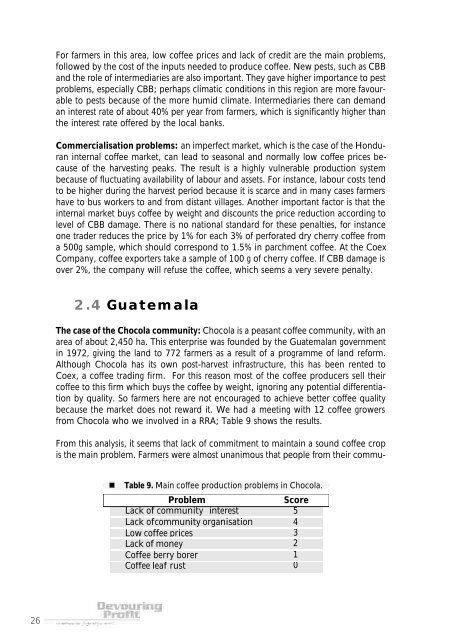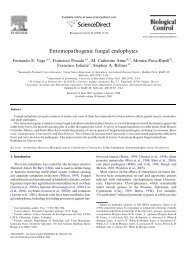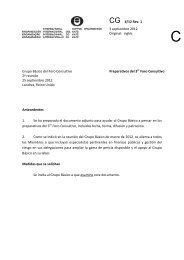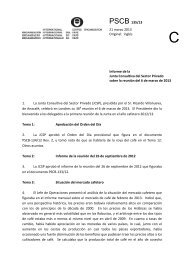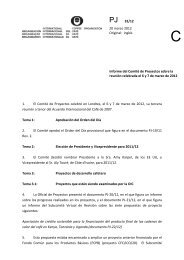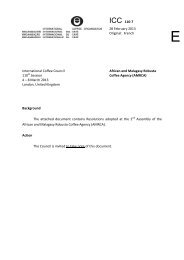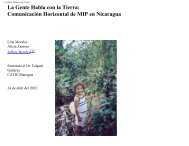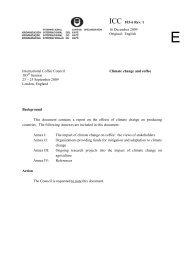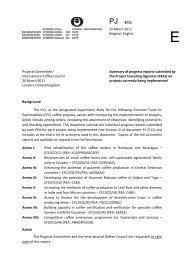Devouring profit - International Coffee Organization
Devouring profit - International Coffee Organization
Devouring profit - International Coffee Organization
Create successful ePaper yourself
Turn your PDF publications into a flip-book with our unique Google optimized e-Paper software.
26<br />
For farmers in this area, low coffee prices and lack of credit are the main problems,<br />
followed by the cost of the inputs needed to produce coffee. New pests, such as CBB<br />
and the role of intermediaries are also important. They gave higher importance to pest<br />
problems, especially CBB; perhaps climatic conditions in this region are more favourable<br />
to pests because of the more humid climate. Intermediaries there can demand<br />
an interest rate of about 40% per year from farmers, which is significantly higher than<br />
the interest rate offered by the local banks.<br />
Commercialisation problems: an imperfect market, which is the case of the Honduran<br />
internal coffee market, can lead to seasonal and normally low coffee prices because<br />
of the harvesting peaks. The result is a highly vulnerable production system<br />
because of fluctuating availability of labour and assets. For instance, labour costs tend<br />
to be higher during the harvest period because it is scarce and in many cases farmers<br />
have to bus workers to and from distant villages. Another important factor is that the<br />
internal market buys coffee by weight and discounts the price reduction according to<br />
level of CBB damage. There is no national standard for these penalties, for instance<br />
one trader reduces the price by 1% for each 3% of perforated dry cherry coffee from<br />
a 500g sample, which should correspond to 1.5% in parchment coffee. At the Coex<br />
Company, coffee exporters take a sample of 100 g of cherry coffee. If CBB damage is<br />
over 2%, the company will refuse the coffee, which seems a very severe penalty.<br />
2.4 Guatemala<br />
The case of the Chocola community: Chocola is a peasant coffee community, with an<br />
area of about 2,450 ha. This enterprise was founded by the Guatemalan government<br />
in 1972, giving the land to 772 farmers as a result of a programme of land reform.<br />
Although Chocola has its own post-harvest infrastructure, this has been rented to<br />
Coex, a coffee trading firm. For this reason most of the coffee producers sell their<br />
coffee to this firm which buys the coffee by weight, ignoring any potential differentiation<br />
by quality. So farmers here are not encouraged to achieve better coffee quality<br />
because the market does not reward it. We had a meeting with 12 coffee growers<br />
from Chocola who we involved in a RRA; Table 9 shows the results.<br />
From this analysis, it seems that lack of commitment to maintain a sound coffee crop<br />
is the main problem. Farmers were almost unanimous that people from their commu-<br />
Table 9. Main coffee production problems in Chocola.<br />
Problem Score<br />
Lack of community interest 5<br />
Lack of community organisation 4<br />
Low coffee prices 3<br />
Lack of money 2<br />
<strong>Coffee</strong> berry borer 1<br />
<strong>Coffee</strong> leaf rust 0


